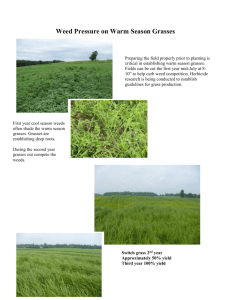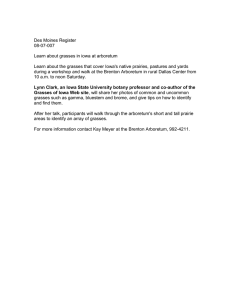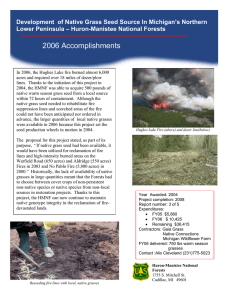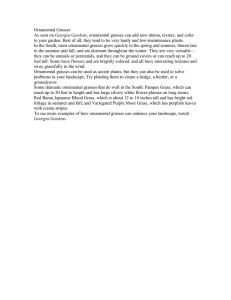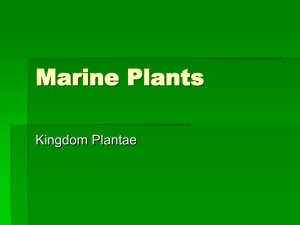written by Mary Hockenberry Meyer, Extension Horticulturist, 7/1999.
advertisement
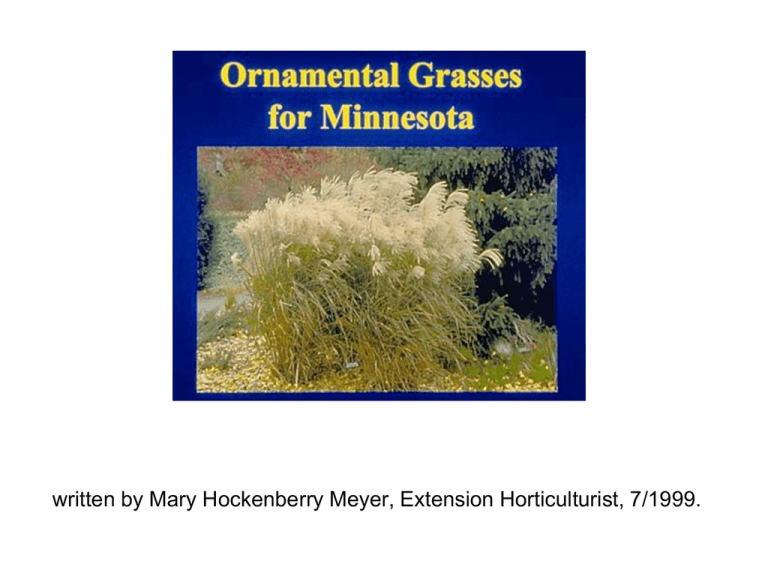
written by Mary Hockenberry Meyer, Extension Horticulturist, 7/1999. Ornamental or landscape grasses are beautiful plants to use in a garden. Noerenberg Gardens, part of Hennepin County Parks, west of Minneapolis, is a good place to see grasses in a garden setting. Shown here are Indian grass, Sorghastrum nutans, on the right; Pennisetum orientale, oriental fountaingrass, front center and blue oatgrass, Helictotrichon sempervirens, left center. Most of the grasses in this slide set are hardy perennials in USDA Hardiness Zones 3 & 4. Pennisetum orientale is grown as an annual north of Zone 6. Grasses have many features that make them popular in the landscape. As you read this list, you realize how few other perennials can claim all these characteristics. Item # 3, spring cutback, will be discussed later. Let’s begin by looking at the fourth characteristic, more than one season of interest. The seasonal changes and different appearance of grasses throughout the year is one of the main reasons people love to plant them in their gardens. Here is blue oatgrass, Helictotrichon sempervirens, the spring, its silvery blue foliage compliment the pastel pink XHeucherella, ‘Bridget Bloom’, coral bells, at the front of this border. Another stunning spring combination is hakone grass, Hakonechloa macra ‘Aureola’ with Phlox divaricata ‘Charles Ricardo’. Hakone grass needs moist soil and winter protection in Zone 4. It also prefers some shade and is a slow growing plant. Sometimes it is referred to as a “yellow waterfall” because of its arching foliage. Late June finds feather reedgrass, Calamagrostis xacutiflora ‘Karl Foerster’ in bloom. This 4’ tall slim, upright grass adds a beautiful vertical accent in the perennial border. Here is the same plant a few weeks later, with its flowers contracted and beige. It maintains this “wheat-like” appearance for the rest of the year. In front is rattlesnake master, Eryngium yuccifolium, the yellow flowers is oxeye, Heliopsis helianthoides; and the bright purple gayfeather, Liatris spicata, are on the right. Late summer is the prime time for the warm season grasses, such as Panicum virgatum ‘Rehbraun’, red switchgrass to bloom. This native grass can reseed, but it is loved by wildlife for food and winter cover. Miscanthus, the most popular ornamental grass in the US, blooms in late summer. Here is the cultivar ‘Graziella’, with its white firecracker flowers in September. Winter protection is recommended for this cultivar. This is the same plant in October, with its orange-yellow fall color. And in again the winter, Miscanthus sinensis ‘Graziella’, provides us interest in the garden. Grasses are known for fall color. Miscanthus sinensis ‘Purpurascens’, red flame miscanthus, reflects this in its common name. This type is very hardy for all of Minnesota, and is 4-5’ in height. Another look at winter interest, of great importance for northern gardeners. Shown is switchgrass, Panicum virgatum. Place grasses where you can see them from inside, to enjoy them throughout the winter. Another feature of the grasses is their fast growing nature. Shown here are Jean Larson and Mary Meyer at the Minnesota Landscape Arboretum in front of the giant miscanthus, Miscanthus xgiganteous, which grows to 10’ each year. All grasses die back to the ground in winter, so their growth can be very rapid, especially for the taller plants. Look at the wide variation in texture of miscanthus foliage. The giant plant of the previous slide has foliage 2”wide, shown here at the bottom, ranging up to the finest texture of ‘Morning Light’ and ‘Gracillimus’. Color variation, in the fall or throughout the season is another attractive feature of the grasses. The white plant in the foreground is ribbon grass, Phalaris arundinacea ‘Feecey’s Form’, a very showy but rhizomatous grass. (Invasiveness will be discussed later.) Behind it are red flame, Silver Feather and giant miscanthus. Molinia, with its showy yellow fall color is on the right. Movement in the wind is an attractive feature of grasses. Here Autumn Light miscanthus bows to the wind from the northwest. And don’t overlook the audio features, many people love to hear the grasses rustle in the wind. Now that we have looked at some of the features of ornamental grasses, lets dispel two common myths, or misconceptions about grasses. After more than 10 years of research at the University of Minnesota’s Landscape Arboretum, we know that many grasses are hardy in Zones 3 and 4. The Extension publications, Ornamental Grasses for Cold Climates, BU-6411; and Ornamental Grasses for Minnesota, FS-6422A, available from your local Extension office list the numerous grasses and their hardiness. And of the nearly one hundred hardy grasses, only a few have creeping rhizomes, the majority are bunch grasses. Four rhizomatous kinds will be highlighted near the end of this slide set. Once you realize the attractive features of grasses, the next question is often “How should I use them in the garden?” The best way is in combination with other flowering perennials. Think of the grasses as you would a peony, lily or Rudbeckia. At the Des Moines Botanical Garden, feather reedgrass makes a vertical accent in a parking lot island with other annuals. A planting on the U of MN Twin Cities campus done by landscape architects, Oehme and Van Sweden, combine blue oatgrass, Helictotrichon sempervirens, left front, with coreopsis and perovskia; feather reedgrass, Calamagrostis xacutiflora ‘Karl Foerster’ is on the right and our native slough grass, Spartina pectinata is in the background. This planting above the Church Street parking garage on the Minneapolis campus of the U of MN is another good place to see grasses. Here is an effective use of grasses in a perennial border, Calamagrostis xacutiflora ‘Overdam’ a 3 ½’ variegated form of reedgrass, shown here in the center of astilbe and heuchera at Noerenberg gardens. Spodiopogon sibiricus, silver spikegrass looks like a shrub, with its shorter, wider foliage. Usually known for showy fall color, silver spike grass has weak stems and doesn’t stand up in winter. Calamagrostis brachytricha, fall blooming reedgrass, flowers in September on 4’ stems. It is attractive when used with Sedum ‘Autumn Joy’. In the background is Molinia caerulea ssp. arundinacea ‘Windspeil', windplay moorgrass, is a tall, 7’grass that has pencil thin stems, which you can see through. A beautiful bunch grass, it is very hardy in Minnesota. Molinia has beautiful yellow fall color. These plants are growing at the West Central Experiment Station in Morris, MN. In the background is the rose garden. This grass planting is part of the hardiness trials and can be viewed by the public at the Experiment Station. A similar planting is at the Crookston Experiment Station. A beautiful grass with red fall color is our native Schizachyrium scoparium, little bluestem. Typically 3’ tall, its arching foliage compliments Aster ‘Purple Dome’, left foreground. Sporobolus heterolepis, prairie dropseed, is another beautiful native grass. Found on lighter sandy soils, it tolerates drought and has soft airy panicles in mid to late summer. It is one of the few grasses with a fragrance when in flower, some think it resembles hot buttered popcorn. At the back is the striking purple Pennisetum setaceum ‘Rubrum’. Pennisetum setaceum ‘Rubrum’, crimson fountaingrass, is a tender perennial, grown as an annual in Zone 4. It sets very little seed and tolerates little frost, so it is costly for growers to overwinter it and propagate is by divisions. It likes heat and tolerates drought. Here it is planted at the Arboretum for the color theme of pinks and purples. Pennisetum setaceum, fountain grass, also is grown as a green form, with pink showy flowers. Like the purple form, it is a tender perennial, and loves full sun and warm conditions. This green form sets some seed, and is often propagated by division. Seed of fountain grass must be started indoors several weeks before they are planted outside. Think of growing these fountain grasses as you would a geranium. Another style of using ornamental grasses is in a “grass garden”, or a collection of plants that are all grasses. The Arboretum’s grass collection is on three-mile drive and contains a large collection of aver 150 different grasses. The original collection was planted in 1987 and data is collected each year on hardiness, flowering time and landscape use. A visit in September or October shows many of the plants at their peak, as shown here. Another famous grass garden is at PepsiCo’s headquarters in New York State where Russell Page designed a grass garden amid a carpet of lawn. You too, could design your own grass garden, making an island bed in your lawn. Most people prefer to use the grasses in combination with other perennials. Or, if time, space and money is not limited, do both! The next few slides deal with grasses as native plants in prairie restoration or natural plantings. Where lots are large or in rural areas, many people are interested in planting a prairie where that will not require regular mowing. Here are some suggestions: Define the natural area by mowing a border around it. The mowed area will indicate care and show that the unmowed area was meant to be there. Use signs, walkways, birdhouses and fencing to show the natural area has a purpose. For more information look for these publications: Establishing and Maintaining a Prairie Garden, FO-6748-C; and Plants in Prairie Communities, FO-3238; from your local Extension office or call1-800-876-8636. Four native grasses should be the backbone of most prairies in Minnesota. Depending on your soil type, you may use other grasses and a variable % of each of these. Big bluestem, Andropogon gerardii was probably the most predominant grass in Minnesota prior to white settlement. It grows 4-6’ tall and prefers wet to mesic (medium moisture) soils. It is sometimes called turkey foot because of its inflorescence or flowers, which resemble a turkey’s foot. Indian grass, Sorgastrum nutans, was also very common. It grows in similar soils, usually found in mesic sites and has showy bronze flowers. This photo shows a few showy Solidago spp. or goldenrod, and many grasses. The prairie probably consisted of a majority of grasses, 60-80 or even 90%, with the remainder of plants being wildflowers or forbs. Little bluestem, Schizachyrium scoparium, is a 3’ tall grass found on mesic to dry sites. It is suited to gravely soil and forms a bunch as you see here. Its showy white flowers are borne in September and October. Its common name comes from the blue color of the summer foliage, which often turns bronze and orange in the fall, as seen previously, (in slide #26). The last of the four predominate grasses of the tallgrass prairie was switch grass or Panicum virgatum. It is a common plant of roadsides and ditches in much of central and southern Minnesota. This 3-6’ plant spreads easily by seed. It favors wet to mesic soils and can grow on dry sites, but will be shorter. A favorite of wildlife for the seed and winter cover. Ornamental forms with red seed and foliage are available in the trade, as shown earlier, (in slides 8 & 13). The Arboretum has planted a transition border using native plants such as Indian grass on the entry drive. With the natural marsh on the right, this border blends the native plants with the mowed edge on the left. Rudbeckia hirta, black eyed-susan, and Liatris spp. gayfeather, provide showy color to visitors as they arrive at the Arboretum. Do you have a shady area to plant? As trees grow and age, there is a greater demand for plants that like the shade. The Carex, or sedges are good plants for the shade. The next time you go for a walk in the woods, look at the forest floor and you will most likely find sedges. The Arboretum’s collection is under a lath structure, along with traditional ground covers, such as periwinkle or Vinca minor, foreground and Pachysandra terminalis, pachysandra, background. Carex flava is a showy yellow color, from spring until late fall. It dies back to the ground in winter, but grows quickly in early spring. Try it in combination with blues and purple flowers. Carex greyi or mace sedge has flowers that look like a medieval mace. Like many sedges it grows well in light to medium shade and heavy soils. On the left is Carex muskingumensis, or palm sedge. Typical of sedges the palm sedge has three-ranks. Looking down a stem you can see the leaves come off at 3 equal distances around the stem. Sedge stems are triangular, not round as true grasses. By rolling the stem between your fingers, you can tell a sedge from a true grass. Here is palm sedge when grown in full sun, which turns it a yellowgreen color. Carex flacca, or black sedge, has mounding foliage that is bluegreen underneath. This is a vigorous sedge that may be invasive. A true grass that grows well in the shade is Deschampsia caespitosa, tufted hairgrass. This cool season grass flowers in June. Caespitosa means bunch in Latin, which describes the growth habit of hairgrass. The flowers of hairgrass resemble clouds of hair, as shown in the background of this U of M planting. In the foreground is a sedum and in the middle coreopsis. The last grass in this grouping for shade is the 12” tall Hakonechloa macra ‘Aureola’. Hakone grass responds best to moist, high organic matter soils and needs winter protection in Zones 3 & 4. Let’s look next at some grasses for planting in or near water. Our native Spartina pectinata or cordgrass is found in ditches and sloughs throughout the state. It can tolerate up to 6” of water and spreads by creeping rhizomes. It is great for soil stabilization along lakes and streams. It is not as aggressive as reed canarygrass, Phalaris arundinacea or common reed, Phragmites australis. An ornamental form, Spartina pectinata ‘Aureomarginata’, has yellow leaf margins. Here are the four most common grasses that spread by rhizomes. These plants will become aggressive in the garden and need confinement or mowing to keep them in bounds. We have looked at prairie cordgrass. Leymus spp. or blue lyme grass, is a coarse, blue grass that grown well in many soils, from sandy seashores to heavy clay. It is grown for its blue foliage, but must be kept in bounds. Ribbon grass, Phalaris arundinacea ‘Picta’ is so attractive with its white, bright striped foliage. But it is so aggressive, many gardeners battle with it each year after they plant it! Its a tough plant, grows in the shade, heavy clay soil, wet ditches, poor soils, withstands mowing at any time of the year, and has no pests and diseases. Be careful where you plant it, mow it to keep in bounds, or plan to divide it often. ‘Feesey’s Form’, shown here, has the best coloring, bright white foliage. If at any time you find a green leaved plant in the clump, pull it out, it will quickly predominate and crowd out the variegated form. This brings us to Miscanthus, a favorite of many gardeners. The arboretum collection has many different species and cultivars of this popular genus. There are more than 50 different miscanthus on the market today. Just as the word peony or daylily can refer to a large group of diverse plants, so does the word miscanthus. In front of a Rochester restaurant grows a clump of Miscanthus sacchariflorus. This is the invasive type of miscanthus and is NOT recommended for planting in Minnesota. Although it flowers early and is fully hardy to zone 2, the aggressive rhizomes are not welcome in gardens. Miscanthus as a group loves water, but plant the native cordgrass rather than this exotic for stabilizing lakeshores. These illustrations show the differences between the two popular types of miscanthus, one with rhizomes and one with dense clumps. Notice the small drawing of an individual floret, see the difference in the length of the hairs surrounding the tiny seed and the small needle-like projection, or awn, on the lower right floret. Here is a list of the difference between the two miscanthus types. Be sure to get a labeled named, cultivar rather than a plant labeled ‘miscanthus’. A few of the best clump forming kinds for Minnesota are listed in the next several slides. Miscanthus ‘Purpurascens’, red flame miscanthus gets it common name from its showy fall color. Like most miscanthus red flame likes plenty of water. It is shorter, growing 4-5’ tall, with flowers in mid-August. ‘Silberfeder’ miscanthus translates to Silver Feather from German. This 6-7’grass has showy, yellow-beige flowers in late August. It tends to arch or fall to the side as it matures. Sometimes slow to grow in the spring, Silver Feather has lived consistently since 1987 at the Arboretum. Miscanthus sinensis ‘Variegatus’ has only died one winter since 1987, so it is a good bet for northern gardeners. Its showy, white foliage catches your eye in the garden. Flowering in September, an early frost can halt flowering. Voted one of their favorites by Master Gardeners who rated the miscanthus at the Arboretum, many people grow this plant for the foliage alone. ‘Malpartus’ miscanthus has showy, dense, red flowers borne above the foliage. This cultivar has survived at the Morris and Crookston Experiment Stations since 1996 as well as the Arboretum since 1992. ‘Autumn Light’ miscanthus is very stiff and upright with red flowers. It looks good in the background of a perennial border. ‘Zebrinus’, shown here, and ‘Strictus’ are two horizontally striped grasses that gardeners love. They have died 3 out of 5 winters over the years of the Minnesota trials. Many people still grow them as annuals and hope with winter protection they will perenniate. Miscanthus are best used in the formal garden with other perennials. In native and prairie plantings, miscanthus is not recommended. Although we have seen only a few seedlings of miscanthus, plants of this genus have escaped and naturalized in North Carolina and Europe. Let’s talk about culture and maintenance of the grasses. Spring planting is preferable, although container grown, hardy plants can be planted in the summer or early fall. Space plants their mature height, cut this in half if you want a screen or plants to touch each other. Division is only necessary when plants are dead in the center, have stopped flowering, or if you want to increase the number of plants you have. Spring cutback is the focus of the next few slides, and winter protection is recommended for marginally hardy plants. Because grasses grow from the base each year, the previous years growth should be cut back in the spring. Early April is the best time to do this in Zone 4. Hand pruners work well, an electric hedge trimmer is ideal, a string trimmer with a blade attachment works also. For large areas, burning can be an easy means of spring clean up. Of course, near a home this is not practical. If you have a prairie planting you may want to burn it off every few years. Check with your local city or town for regulations concerning burning. For more information on hardiness and culture see the publication Ornamental Grasses for Cold Climates, BU-6411, available from your local Extension office or by calling 1-800-876-8636. In closing, let’s look at a planting at Noerenberg Gardens through the seasons. Here is Memorial Day when the Siberian iris are in bloom. On the 4th of July, feather reedgrass is vertical and brown, little bluestem is a green bunch, all along the planting. By October, the grasses are very showy, the little bluestem a beautiful bronze or pumpkin color, feather reedgrass is stiff, upright and beige, and Sedum ‘Autumn Joy’ is a showy dark red. In winter, the grasses stand tall and are covered with hoarfrost. Switch grass, shown at the right becomes a large panicle of ice. A final look at the same bed in midsummer with lots of color. And again in the fall with little bluestem, asters and goldenrod. Using grasses can add a new dimension in your garden. Enjoy them! University of Minnesota Extension Service. Slides compiled and script written by Mary H. Meyer, Extension Horticulturist, July 1999.

